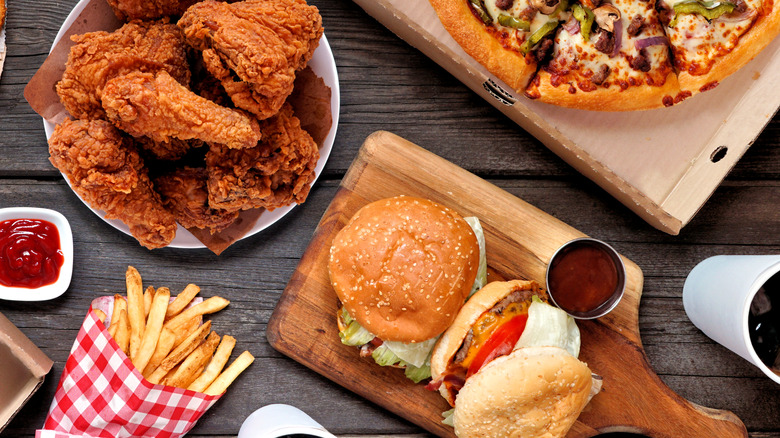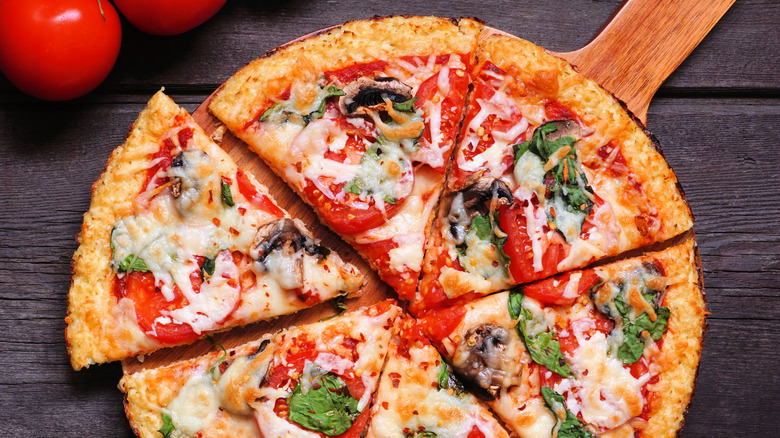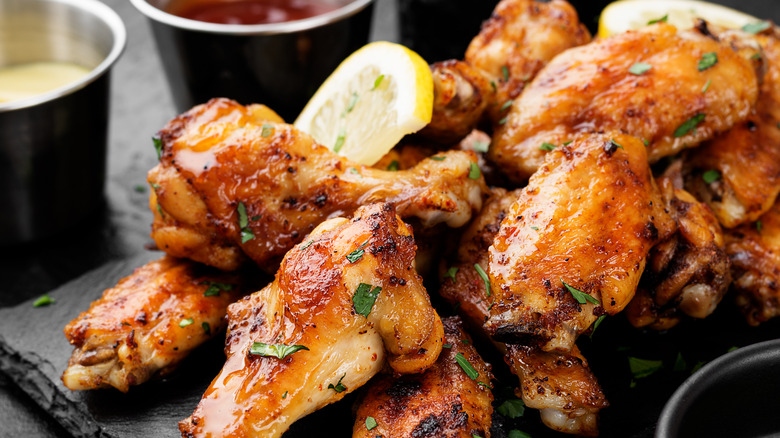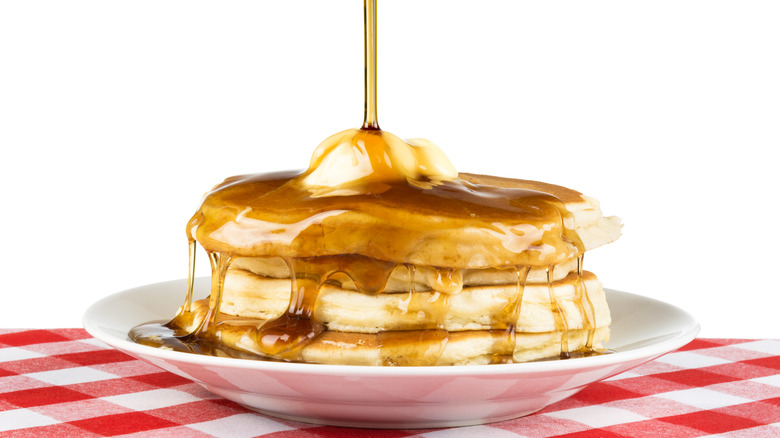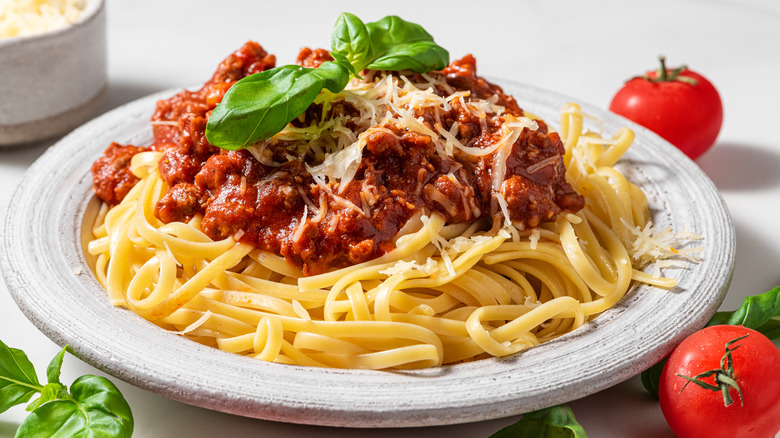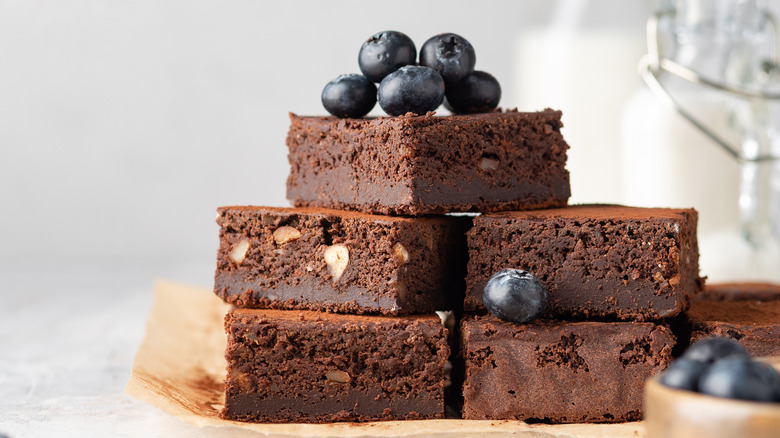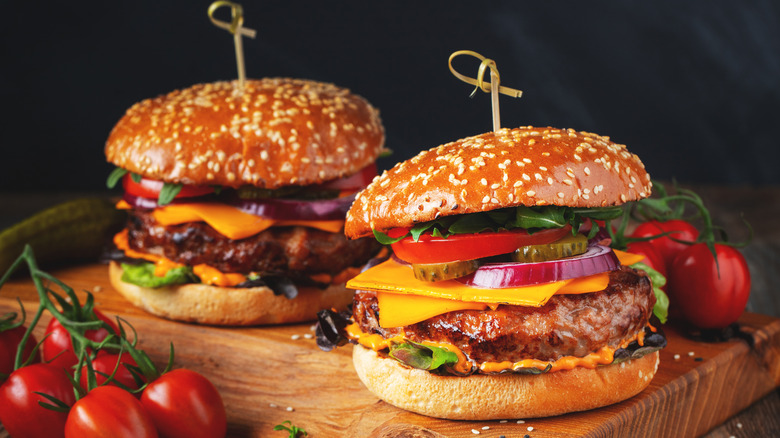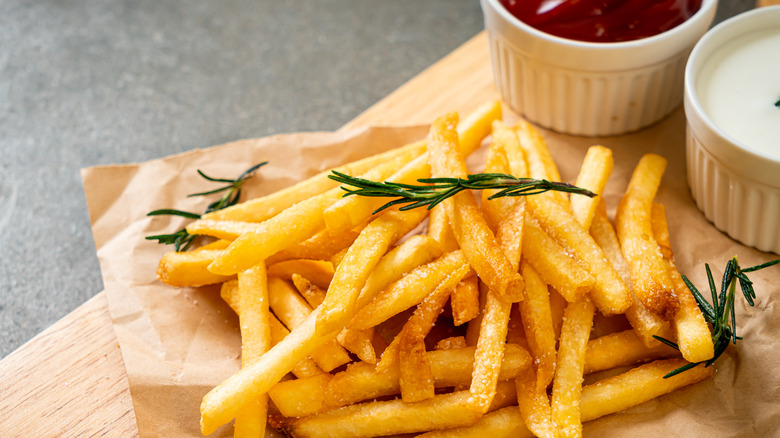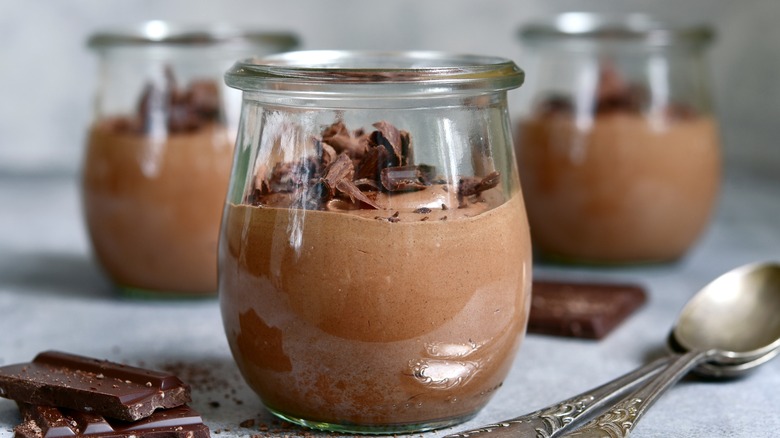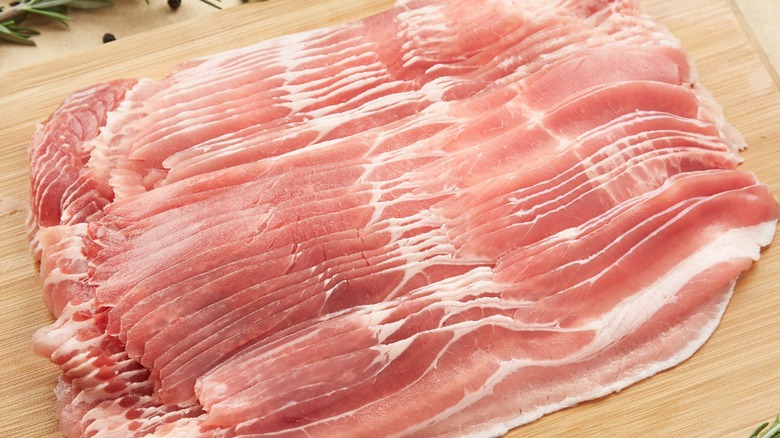Healthier Ways To Cook Your Favorite Foods
Whether you're watching your weight or you just want to improve your overall health and well-being, you'll be happy to know that it doesn't mean you have to give up your favorite foods. You can still enjoy delectable dishes like pizza, pasta, and wings by making a few changes that shave off unhealthy fat, calories, and sugar.
Changing the type of fat you use to cook, changing your cooking method, reducing the amount of sugar or using non-caloric sugar substitutes, and finding novel ways to add more fruits, veggies, and other nutritious ingredients to your favorite recipes can turn your cheat day meal into a healthy any-day meal (via the Better Health Channel and Everyday Health).
Deprivation diets don't work. Depriving yourself of your favorite foods is bound to make you crave those foods even more (via Healthline). Not to mention that it's going to make life a lot less enjoyable. So what is it you love? Crispy, spicy chicken wings? Gooey, rich chocolate brownies? French fries? You can still have them — with less saturated fat, less sugar, less sodium, and more nutrition — with these top tips for turning your favorite indulgences into wholesome, nutritious meals.
Pizza
Most delivery pizza is made with a white flour crust, loads of greasy cheese and processed meats, and scant amounts of vegetables. The refined carbs in the crust will do a number on your blood sugar and the saturated fat in all that cheese is a recipe for a coronary disaster. But that doesn't mean you have to call off pizza night. You just need to do a little home prep with the right ingredients and be open-minded about trying something new.
Whole grains haven't been stripped of all their fiber and nutrients like refined flour has (via the American Heart Association). All that fiber is good for your heart, and it helps your food digest more slowly to sustain your blood sugar levels. Look for whole-wheat or spelt flour crust, or make your own personal pizza on a whole-grain pita or tortilla (via the Cleveland Clinic). You can also try a cauliflower crust, which you can often find in the frozen foods section or in a health foods store (or make yourself).
Cheese is high in saturated fat (the kind that clogs your arteries) and sodium, too much of which can raise your blood pressure. Use less cheese overall, and choose part-skim, fresh mozzarella, and low-fat shredded cheeses. As for sauce, avoid cream sauces and choose healthier options like fresh tomato, olive oil, or pesto. Avoid processed meats like pepperoni, because they can cause cancer; instead, opt for lean meat like grilled chicken and lots of fresh veggies (via the Cancer Council).
Chicken wings
Spicy, juicy, crispy fried chicken wings with a creamy ranch or blue cheese dressing really hit the spot. Eating them every once in a blue moon is OK, but fried foods are high in saturated and trans fats, which cause a buildup of plaque in the arteries and increase your risk of coronary artery disease, heart attack and heart failure, and stroke (via GoodRx Health). They're also crazy high in calories.
You can still enjoy delicious wings, though — you just have to bake them instead. A serving of two fried wings contains more than 300 calories, 21 grams of fat, and over 1,000 milligrams of sodium (which is also bad for your heart health). If you opt for baked wings, a typical serving of two pieces provides only 160 calories, 4.5 grams of fat, and 170 milligrams of sodium (via UCI Health). That's a substantial reduction that could improve your heart health and enable you to eat chicken wings whenever you want!
The key to getting baked chicken wings to come out crispy is to make sure to thoroughly pat the wings dry before adding your spice mixture and popping them in the oven. Moisture on the skin will prevent it from crisping up. You also want to start at a low temp and then crank it up, to ensure the skin gets crispy and the meat inside cooks through.
Pancakes
If you dream of eating a stack of fluffy pancakes slathered with butter and thick oozing syrup every morning and staying healthy, you'll have to keep dreaming. All that refined flour, saturated fat, and sugar will wreak havoc on your waistline and your heart health if you make it a regular indulgence. However, with a few tweaks, you can make your dream of pancakes-every-darned-day a reality.
First off all, get rid of the white flour, which has been stripped of nutrients and fiber during processing (via Joy Bauer). Your body quickly metabolizes it into simple sugars, sending your blood sugar (and energy level and moods) on a roller coaster — and not the fun the kind. Instead, opt for whole-grain flours like whole wheat, buckwheat, or quinoa flour (via Everyday Health).
Next, ditch the sugar and replace it with fruit, like mashed banana, or even sweet vegetables, like sweet potatoes. This will naturally sweeten your cakes and add moisture, fiber, and nutrients. Increase the HQ (health quotient) of your stack even more by adding protein via Greek yogurt or a high-quality protein powder. A high-protein breakfast may promote weight loss, according to a 2014 study. Lastly, skip the syrup in favor of healthier toppings like warm berries, fresh fruit, nut butters, and sweet spices like cinnamon and nutmeg.
Pasta
Few things are as comforting as a bowl of pasta with your favorite sauce. But pasta gets a bad rap, especially among the carb-conscious. The problem with pasta is that most of it is made from refined grains, which have been processed to remove the bran and the germ — and most of the fiber and nutrients (via USDA My Plate). Refined grains have a high glycemic index and spike blood sugar and insulin (per Healthline). Eating high-glycemic foods is associated with overeating, heart disease, and even death (via National Institutes of Health and BMJ).
The other problem is the sauce you choose. Cheesy and creamy sauces are high in fat and cholesterol, and store-bought tomato sauces can contain a surprising amount of added sugars, which can contribute to obesity, type 2 diabetes, and other health problems (via News.com.au and the Centers for Disease Control and Prevention). Many sauces are also high in sodium, too much of which can lead to high blood pressure, heart attack, and stroke (per the American Heart Association).
The solution is simple: Replace refined-grain pasta with whole-grain or legume-based pastas and choose your sauces wisely. Save creamy, cheesy sauces for the occasional indulgence, and read the labels of store-bought sauces carefully. Healthy pasta sauces are easy to make at home. Try pesto with heart-healthy olive oil, fresh basil, and pine nuts. Make a primavera sauce with fresh tomatoes and lots of veggies. Add some chicken breast or fish for a dose of muscle-building lean protein.
Brownies
First, the good news: It's OK to enjoy chewy, fudgy, gooey brownies every once in a while. Now, the bad news: They really do have to be an every-once-in-a-while treat if you want to stay healthy. Most brownies, especially store-bought mixes, are loaded with unhealthy ingredients like sugar and refined flour, both of which wreak havoc on your blood sugar (via Betty Crocker and Healthline). Eating a lot of refined grains and sugars can lead to obesity, heart disease, and type 2 diabetes. Fortunately, with a few tweaks and substitutions, you can make healthier brownies that you can enjoy more than once in a while (everything in moderation, of course).
One big tweak is to reduce or replace the sugar with non-caloric sweeteners that don't affect your blood sugar. A few of our favorites to look for are erythritol, stevia, and monkfruit. These are all-natural plant-based alternatives to non-caloric sweeteners like sucralose, the safety of which is still under investigation. You can find tons of recipes online for sugar-free brownies using these sugar stand-ins. You can also use fruit to sweeten your brownies. Bananas, pineapple, and mango all work well in baking. They will add not only sweetness, but a little extra nutrition, too.
Another healthy strategy is to swap the refined flour for whole-grain flour. Whole-grain flour doesn't work as well in light, fluffy cakes because it's denser (via King Arthur Baking). But that makes it perfect if you like your brownies fudgy and chewy.
Burgers
If hitting the drive-thru for a cheeseburger with all the fixins is your go-to way to destress after a day of work, it's not doing your health any favors. Eating too much red meat isn't good for you. A 2012 study by Harvard researchers found that eating a serving of unprocessed red meat every day raised the risk of death from cancer and cardiovascular disease by 13 percent.
The main problem with red meat is saturated fat, too much of which can raise your cholesterol levels and increase your risk of heart attack and stroke (via the American Heart Association). That's in addition to the saturated fat in the cheese, mayonnaise, and other fatty condiments. Plus, hamburgers are often high in sodium and served on refined-grain buns, neither of which is good for you on a regular basis.
But don't worry. You can still have your burger and eat it too, so to speak, if you make it at home with healthy ingredients. First, if you're going for beef, choose lean or extra lean. You can also make delicious lean burgers with turkey, chicken, or salmon. Next, go easy on the cheese and choose low-fat condiments. Skip the mayo and make a Greek yogurt tzatziki dressing instead. Then, load up your burger with fresh veggies like sliced tomato, lettuce, and onion. Veggies are high in fiber and will help fill you up (via Healthline). Finally, choose a whole-grain bun that is higher in fiber and nutrients than refined-grain buns.
French fries
No burger is complete without a side of crispy, salty french fries. Unfortunately, deep fried foods can't be on the menu when you're trying to live a healthier lifestyle. French fries are loaded with saturated and trans fats, both of which raise your cholesterol levels and can cause heart disease (via the Mayo Clinic). Salt, or sodium, is another killer — literally. Too much sodium in your diet can contribute to kidney stones and kidney disease, cancer, osteoporosis, stroke, and heart failure. The American Heart Association (AHA) recommends adults keep their sodium intake below 1,500 milligrams a day. One large serving of a popular fast food brand's french fries contains almost 450 milligrams of sodium — nearly one-third of the AHA's daily recommended limit (via MyFoodData).
Your best option is to have a nice fresh salad with your homemade healthy burger, but we get it — sometimes, you gotta have fries! Here are a few tips for keeping your health in check and your arteries clear: Bake, don't fry. You need far less oil, and can save yourself a ton of calories and fat. You can also use olive oil, which contains healthy monounsaturated fats and has been shown to reduce the risk of heart disease (via Healthline). Go light on the salt and use herbs and spices, such as garlic, paprika, cumin, cilantro, and parsley, to add heart-healthy flavor.
Birthday cake
A birthday isn't a birthday without a big, rich cake with lots of icing. But it's pretty obvious that cake isn't healthy. Loaded with sugar, calories, fat, and sometimes high-fructose corn syrup and artificial flavors and coloring, eating a lot it of could reduce your chances of living a long life and seeing a lot more birthdays. Steer clear of store-bought cakes, and make your own so you can monitor the ingredients and make some healthful changes.
Switching the type of oil you use in your cake can make a difference. Using unsaturated fat, such as canola or olive oil, instead of butter will reduce your intake of saturated fat, which has been linked to heart disease. According to Diabetes Care Community, it will also make your cake lighter, fluffier, and moister. You can also reduce the amount of sugar and replace part or all of it with non-caloric sweeteners (such as monkfruit and stevia), that have a low glycemic index and no effect on blood sugar (via Medical News Today). You can further reduce the impact on your blood sugar by replacing white flour with whole-wheat flour. If you're making a chocolate cake, swap milk chocolate for dark chocolate, which is lower in sugar and higher in cancer-fighting antioxidants (via Harvard T.H. Chan School of Public Health). Lastly, reduce the amount of icing you use or use a sugar substitute.
Chocolate mousse
Easy-to-make, rich and delicious, chocolate mousse isn't the worse dessert you can indulge in. But it's still a dessert high in fat and sugar. It can be made healthier, though — and the healthier you can make your favorite foods, the more often you can indulge in them.
What's the secret to healthy chocolate mousse? Dark chocolate and avocado, both of which are considered superfoods due to their nutrient density (via The Guardian and the Mayo Clinic). Dark chocolate is lower in fat and calories than milk chocolate and higher in nutrients, including iron, zinc, magnesium, and phosphorous. It's also a rich source of antioxidant nutrients called flavanols that may boost heart health (via Harvard T.H. Chan School of Public Health).
Meanwhile, avocado is a rich source of vitamins, minerals, and fiber, and 50% of its fat content comes from heart-healthy monounsaturated fat (via the Mayo Clinic). Avocado's richness and creaminess make it the perfect sub for heavy cream in your favorite chocolate mousse recipe. Heavy cream is a source of saturated fat, which isn't good for your heart (via Healthline).
Ice cream
I scream, you scream, we all scream for ice cream — and for good reason. It's creamy, delicious, refreshing, and comforting. It's also high in fat, sugar, and calories. Bummer! Does that mean you have to give it up for good? No, but don't make regular store-bought ice cream an everyday kind of thing. With a little creativity and kitchen magic, you can whip up an icy, creamy treat that satisfies your craving for the real thing without adding inches to your waistline.
First thing you can do: Just eat a smaller serving. Take up the rest of the room in your bowl with fresh fruit, nuts, Greek yogurt, or low-sugar granola. If that doesn't do it for you, try one of the sugar-free ice creams on the market, such as Halo Top. One serving of Halo Top Vanilla Bean ice cream has about half the calories, less than a fourth of the saturated fat, and less than half the sugar of regular vanilla ice cream (via MyFoodData).
You can also pull out your ice cream maker and make your own. In fact, you can use fruits and veggies to lower the sugar and fat content and up the nutrient content of your frozen treat. Sweet potato ice cream made with baked sweet potato, dark chocolate chips, coconut sugar and coconut milk is a delicious and nutritious option. Or you can make a creamy treat using just bananas! It's not called "nice cream" for nothing.
Bacon
America loves bacon. According to a Statista survey, over 16 million Americans consumed 5 pounds or more in 2020. Hey, that was a pretty rough year, so it's understandable that you'd want to escape your worries in the comforting crackle of several pounds of crispy pork. But let's not make that a habit. As a processed meat, bacon is usually treated with chemicals — nitrates or nitrites — used as preservatives to prolong shelf life and enhance the color (via TIME Magazine). Eating a lot of processed meat containing these chemicals increases the risk of cancer.
Not to mention that bacon is full of saturated fat, with one serving of three slices providing 22% of the DV (via MyFoodData). It also contains upwards of 600 milligrams of sodium, or more than a third of what the AHA recommends as the limit for adults each day.
So what's a bacon-loving American to do? Eat less of it and find healthier ways to cook it. The healthiest way to cook bacon is one in which the fat is allowed to drain away from the meat instead of pooling around it. Baking your bacon on a wire rack in the oven will do the trick. Before eating it, blot it with a paper towel to absorb any excess oil. You can also try grilling it, or microwaving it on a stack of paper towels (which will absorb a lot of the grease).
